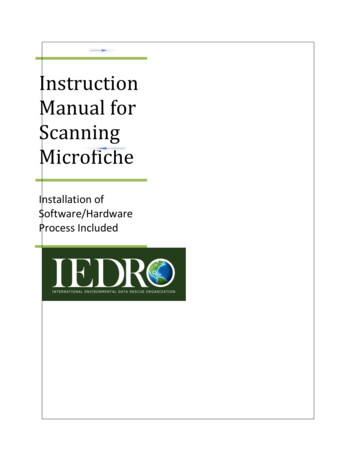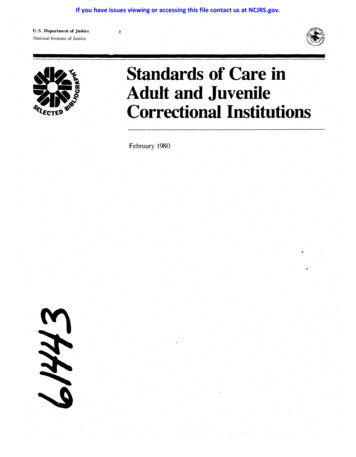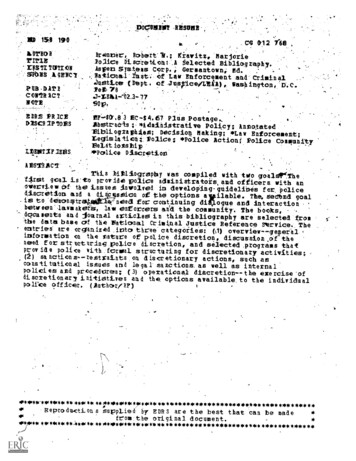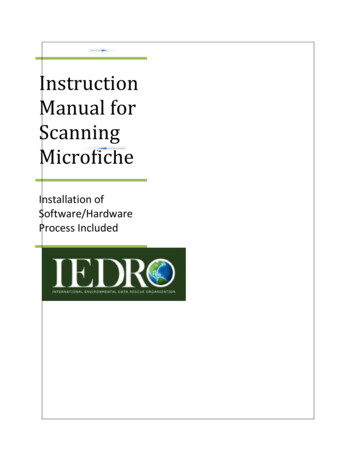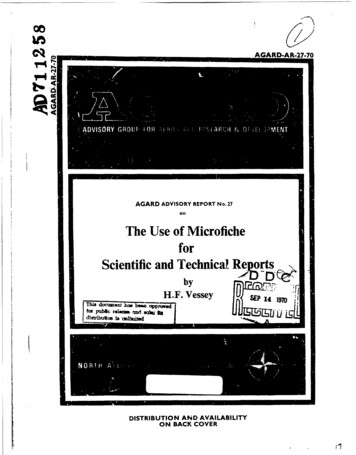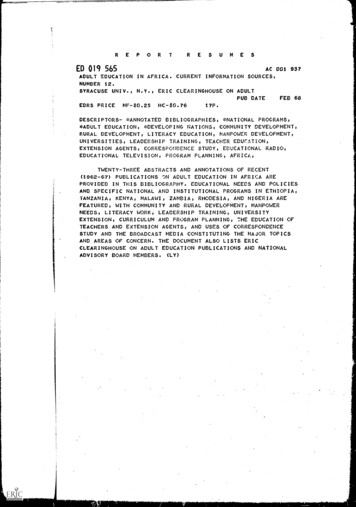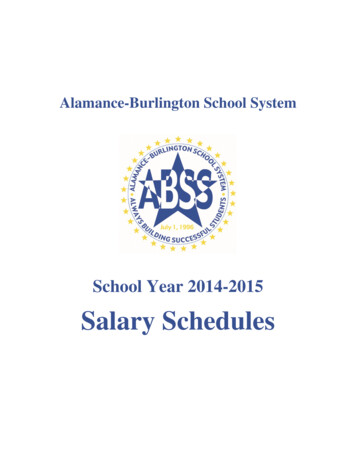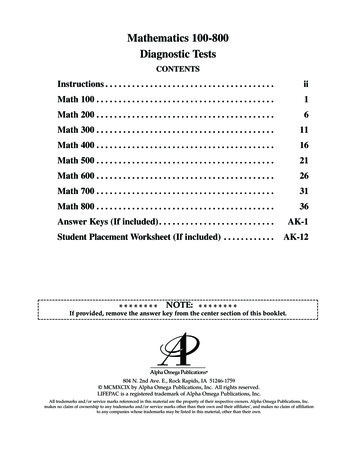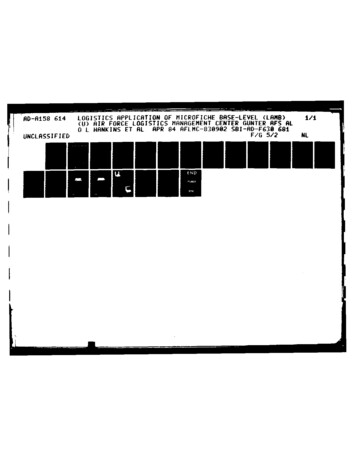
Transcription
LOGISTICS APPLICATION OF MICROFICHE BASE-LEVEL (LAMB)(U) AIR FORCE LOGISTICS MNAGREMENT CENTER GUNTER AFS ALAPR 84 RFLMC-838982 SBI-RD-F638 681RSIID 0 L HANKINS ET RLAD-Ai58 6147Eh hEEEEE7hiENEllmmlmmmm.UNCLASSIFIEDIF/G 5/2i/iI.naa
111.0 Rg-'S1111*1"*o111112.01111U.MICROCOPY RESOLUTION TEST CHART--)ARDS-1963-A
AIR FORCE LOGISTICS MANAGEMENT CENTER00Ln0LOGISTICS APPLICATION OF MICROFICHEBAR-LEVEL (LAMB)byCMSgt Otis L. lankinsAFLMC Project 830902Maj Larry A. SnyderMaj Dan E. KingMaj Gene LindseySMSgt Larry ChambersSMSgt John ChapmanApril 1984ELECTEKSEP 04M8EAIR FORCE LOGISTICS MANAGEMENT CENTERGUNTER AFS, AL. 34114UfdomuIN man.,.'.,'.:.,-:-.-.,'. .- . . . . .-prbm&--: x .-S."S-S.,.:,., ,.,'.',3,XA,.X.0 ra. . 'x'
FORWARDIN CONDUCTIG RESEARCH ON THIS PROJECT AND CONTACTING OPERATIONAL COMMANDS,All FeORCE DIRECTORT OF AUTOMO, AND TE WARNER ROBINS MKiNTOVAAG,SEVERAL CHANGES MATZ BEENuiTuuO.]aWHICH AFFECTED WHAT WE WOULD HAVEUCOMNIDID.FOR EXAMPLE, T UHAS BEN A RIDUCED EMPHASIS ON CONVERTINGHARD COPY DOCUMETS TO MICROFICHE (AIM 12-50, WHICH WAS SCHEDULED TO CONVERTTO MICROFICHE, HAS REMAINED HARD COPY). ADDITIONALLY, TA 007, "ATOMATIC ONENTS(OFFICEINFORMATION SYSTES),WHICH DID NOT CONTAIN A MOBILITY AIJTHORIZATION FORMICRO'FICHE VIEWERS, WAS REVISED ON 15 JANUARY 1984, AND NOW CONTAINS AMOBILITY AUTHORIZATION.WE THANK THOSE INDIVIDUAL WHO HAVE MADE THOSECHANCES AND IMPROVED THE OPERATIONAL CAPABILITY OF TIM AIl FORCE.ForTI:iSGRA&I1.TIC TBflAceeSiofU[naicatlolrlncedDiI.ributi, O/1 lIV ,iiitY! CodeSind/orDTIZO ELECTEE- 0 l I85xm11
ABSTRACTThe purpose of this project was to determine the peacetime and wartimeimpacts of not having appropriate microfiche viewers at base-level and ropriateequipmentavailability.-'Uim puba isdbMMWI
EXECUTIVE SUMMARYN.The current trend of converting reference material or written records tomicrofiche is being driven by rising costs associated with the creation andhandling of hard copy documents. This trend appears to enhance ourdeployability of these references or documents. However, the Air Force mustalso consider the deployability of micrographics equipment.Most of the microfiche equipment in the Air Force inventory does not offerthe flexibility called for during peacetime deployments or contingencyoperations due to size (portability) and power requirements, (worldwide 110/220 volt, 50/60 cycle AC, 12 volt DC). Until Table of Allowance 007,Automatic and Electronic Admianlstrative Support Equipment and Components(Office Atomation Systeam), was revised on 15 January 1984, there was noguidance for authorizing portable, worldwide usable microfiche equipment.This report recommends:a. MAJCOMs should review current microfiche viewer authorizations todetermine additional quantities required to support mobility tasking.Newauthorizations and procurements should be for the portable microfiche viewersincluded in TA 007, dated 15 Jan 84. (OPR: MAJCOM/LGs)b. MAJCOMs should assess their current inventory of microfiche viewersand take action to correct packaging and power requirement deficiencies.(OPR: MAJCOM/LGs)c. AFLC should update TA 007. Portable microfiche viewer, NSN 6730-011504137CU, should be specifically included in allowance source codes BBAthrough BBW. Basis of issue for this portable viewer should be as required fordeployment/mobility or mission support.A.a.Iili(OPR:AFLC/MM)
TABLE OF CONTENTSPAGEABSTRACT.Io .ii.EXECUTIVE SUMMARY .TABLE OF CONTENTS-. o.ivCHAPTERSI - THE PROBLEM. .1-1Project Background.11-2. .0o. .o.Problem Background .Problem Statement . 6.11-32-IDEVELOPMENT .I2.22-1Approach .2-2Result s . o.0.200e.9.53 -CONCLUSIONS .4-RECOMMENDED IMPROVEMENTS .4-1Improvement Recommendations.6.6ATTACHMENTS1. Logistics Application of Microfiche Base-Level (LAMB) Letter2.Sample Photos of Portable Microfiche Viewers3.List of Mobility Microfiche Documentsp.' S*S4 . dJ/*9 -Wiv\
CHAPTER ITHE PROBLEM1-1 Project Background.During their 20 January 1982 meeting at the AirForce Logistics Management Center (AFLMC), the Board of Advisors (BOA)suggested we get actively involved in air base survivability issues.Thisproject was established under the AFLMC Logistics Survivability Five-YearProgram Area.1-2 Problem Background. The Air Force has and continues to convert referencematerial or written records to microfiche. These documents include TechnicalOrder Indexes, Tables of Allowances (TAs), stock lists, etc.Although thiswould appear to enhance deployability of these references or documents, theAir Force must also consider the deployability and usability of microficheequipment required to read microfiche.Planned deployment locations require that we be prepared to operate undera variety of conditions and threats.For example, during peacetimedeployments such as Team Spirit, Bright Star, Proud Phantom, and Reforger theAir Force encountered different electric power sources and environmentalconditions than those available at home station.Additionally, deploymentrequires equipment and packaging which can withstand the hardships of cargomarshalling and handling.Additionally,sincemicrofiche equipment breaks, compatibility ofmicrofiche viewers at a deployed location would enhance a unit's capability tokeep a maximum number of microfiche viewers operational.1-3 Problem Statement. Microfiche support for wartime tasking is inadequatefor the following reasons:a.Lack of guidance.b.Lack of mobility allowances in TAs.c.Physical limitations and diversity of currently authorized microficheequipment.-t-.V.
CHAPTER 2DEVELOPMENT2-1 Approach.The following approachpotential impacts.wasusedto identifyproblemsanda. Review of publications and contact with other DoD and Air Forceagencies to determine trends in converting hard copy to microfiche.b.SurveyAttachment 1.ofMAJCOMs.*c. Analyze equipmentdeployed ploymentcanandbefoundoperationd. y, and currency of microfiche viewer authorizations.ininadequacy,e. catalogs to determine what types of microfiche viewer equipment are readilyavailable, as well as estimated costs.2-2Results.All of the above efforts were combined to evaluate potential deficienciesin the microfiche viewer equipment area.This evaluation resulted inidentification of base-level microfiche viewer equipment shortcomings.a. Our review of the types of documents already converted to microficheindicated that critical logistics support functions require micrographicequipment when deployed. For example, all Terminal Facilities Guides and moststocklists are on microfiche.Additionally, several other regulations andmanuals critical to deployed operations have already been converted tomicrofiche. (See Atch 3)We also reviewed the trend in converting hard copy into microfiche.AirForce Regulation 5-2, "Standard PublIcatiens In Nicreform," provides policy inconsidering whether to convert to microfiche:(1) Fiche are cheaper thanhard copy, and (2) The publication will be easy to read or easier to use onfiche than on hard copy.*Based on this policy and our discussion with both USAF/DA and MAJCOMpersonnel the Air Force will continue to convert hard copy to fiche wheneconomics and usability dictate.b. We asked Air Force major air commands to review the impact ofmicrofiche viewers on their ability to deploy and operate in a deployedenvironment.Based on their inputs, the Air Force has overlooked therequirement for deployment of microfiche viewers during the same time framethat they are being used at home units.For example, virtually all MACmaintenance activities report they would be unable to support generation2:
I.'deployment situations, or deployment requirements, if day-to-day operations athome station were conducted simultaneously.Furthermore,most of SAC'sfunctional areas report they do not possess sufficient microfiche viewers forcontingency commitments.c. Shortcomings also exist in the capabilitymicrofiche viewers at the deployed location.to deployandoperate(1) Power Requirements:Approximately 5% (1041)of Air Forcemicrofiche viewers operate on 110 volt, 60 cycle current.These viewers arenot readily adaptable to the 220 volt, 50 cycle current in Europe andelsewhere. In most cases, this equipment can be "rigged" to work by adding atransformer and changing the extension cord male adapter. However, most unitshave procured equipment based on day-to-day home station requirements withoutconsidering it may have to be used in other areas.(2) Deployment Requirements: Because of the wide use of microfiche,microfiche viewers must accompany units during deployments.Although currentequipment items are listed in the TA as "portable," they are not.They arebulky and fragile.Most are too large for one man to carry safely and arelikely to break when dropped from heights greater then three or four feet.Also, because of internal motors and glass screens, extensive packaging andcareful handling are required for anything beyond interoffice moves.Basedupon our review of microfiche currently in the inventory, at least 98% do notmeet portability requirements.A portable microfiche viewer must meet thefollowing criteria:a.Built-in worldwide AC electric power compatibility.b. Built-in DC rechargeable battery pack.c. Small (briefcase size), lightweight (less than 20 pounds), andruggedized (withstands falls from four feet, aircraft vibrations, andtemperatures from -10 to 190 degrees F).Y.(3)Backup Power:Another major shortcoming identified is thatcritical areas such as supply research, allowance and authorizations, repaircycle support, and the mission capability (MICAP) section must have backuppower due to heavy reliance on microfiche (no hard copy backup exists for manyof their source data documents).Provision for backup power (self-containedbattery power) is essential for mission accomplishment during electrical poweroutages or failures.After evaluating the above shortcomings, we determined that lack ofappropriately configured or sufficient quantities of microfiche viewers wouldhave a detrimental impact on mission support. Mission impacts, identified inFigure 2-1, were developed as a result of MAJCOK inputs.A3
IMPACT OF DEFICIENCIES ON MISSION1.Cannot generate and deploy with current equipment on hand andstill support home base requirements.Workarounds required to deploy current equipment.2.3. Causes an increase in manhours and personnel.4. Wartime location could render current equipment useless based onpower requirements.5. Delays in supporting wartime mission without backup power.FIGURE 2-1d. We reviewed TA 007, "Automatic and Electronic Administrative 8upportEquipment and Compomeats (Office. Informatio Systems),". dated 1 July 1983, todetermine if. this document provided. allowances.for.mobility requirements andlisted microfiche viewers which satisfied the "deployable criteria" listed inThe introduction to TA 007 specifically states,paragraph 2-2 c. above."Excluded are war reserve naterial (URN) allowances." Additionally Section Bof TA 007 did not contain allowances for microfiche mobility requirements nordid it list microfiche equipment which satisfies necessary portability andFor example, the Realist/Vantage IV, NSN 6730-01-038-2447power requirements.had been designated to replace the Mini-Cat 1114, because the Mini-Catprojects a fuzzy, indistinct image which has caused eye strain, headaches,etc.However, the Realist/Vantage IV operates only on 110 volts, 60 cyclepower. TA 007 did list a microfiche viewer as portable (Ektalite 140 Reader,NSN 6730-00-111-5313). However, we physically examined this microfiche viewerand it's bulky, fragile and required extensive packaging for anything beyondTA 007 also provided an allowance for a microfichean interoffice move.which allows the user to obtain a viewer of any6730-00-469-9521)viewer (NSNthe flexibility to obtain microfiche viewersprovidesThisconfiguration.However, it depends on thewhich meet portability and power requirements.initiative and foresight of the individual establishing the authorization toconsider potential worldwide mobility requirements for the viewer.e.The 15 Jan 84 TA 007 has changed and a portable microfiche viewerwhich mets deployment requirements has been included. However, this portablemicrofiche viewer is currently identified only to supply (allowance sourceThe national stock number, item description and basis of issue,code BBR).like that listed in allowance source code BBR, should be added to allowancesource codes for other base/wing activities from BBA through BBW. Basis ofissue should be as required for deployment/mobility or mission support.4I4
,f. We reviewed the availability of "off-the-shelf" microfiche viewerswhich would meet the deployability and power requirements.There have beenseveral microfiche viewers designed for portability which also meet the powercriteria established in paragraph 2-2 c. above. These w-Kit (Visidyne)Tec-Kit lbs14.OlbsBriefcaseBriefcaseRealist Agent (Realist)WSI Elite II bs16.OlbsBriefcaseBriefcase.4Each of the above microfiche viewers meet worldwide deployment requirements(see attachments 2-1 through 2-3 for greater detail).: '.4-5.X."4B.
CHAPTER 3CONCLUS IONS3-1 General. Our findings revealed serious deficiencies in microfiche viewerguidance, TAs, and equipment. MAJCOMs cannot meet their peacetime mission anddeployment mobility requirements at the same time with the quantities andcapabilities of currently authorized equipment.Many deployment destinationsrequire the ability to operate under allcircumstances.There is a need tohave a 110/220 volt, 50/60 cycle capability as well as battery backup powerfor logistics areas identified as mission critical. In addition, much of theequipment currently in the inventory are not portable.They are bulky,fragile, and require extensive packaging and handling for anything beyondinteroffice moves.Therefore, recommendations are proposed that will assureadequate and appropriate equipment availability for peacetime and wartimeuses.94PC6:4
CHAPTER 4RECOMMENDED IMPROVEMENTSRecommended Improvements. Managers must be able to provide the right amountof mission ready equipment in the proper configuration to give routine supportin peacetime, and higher levels of support during exercises and contingencies.To provide this capability, the following recommendations are made:a. MAJCOMs should review current microfiche viewer authorizations todetermine additional quantities required to support mobility tasking.Newauthorizations and procurements should be for the portable microfiche viewerincluded in TA 007, dated 15 January 1984.(OPR: MAJCOM/LGs)b.MAJCOMS should assess their current inventory of microfiche viewersand take action to correct packaging and power requirement deficiencies.(OPR: MAJCOM/LGs)c. AFLC should update TA 007.Portable microfiche viewer, NSN 6730-011504137CU, should specifically be included in allowance source codes BBAthrough BBW.Basis of issue for this portable viewer should be as requiredfor deployment/mobility or mission support.(OPR: AFLC/MM).U7
DEPARTMENT OF THE AIR FORCE"AIR FORCE LOGISTICS MANAGEMENT CENTERGUNTER AIR FORCE STATION. AL 36114ORATTN oF2 2 SEP 1983AFLHC/CDLogistics Application of Microfiche Base-Level (LAMB)JSUBJECT--TOAAC/LG1. The current trend of converting reference material or written records tomicrofiche is being driven by rising costs associated with the creation andhandling of hardcopy documents. While this trend would initially appear toenhance our deployability of these references or documents, it also raisesquestions regarding the reliability of micrographics.Microfiche readers,currently listed in the Table of Allowance (TA) 007, may not offer theflexibility called for during peacetime or contingency operations due to size,power requirements, quantities and types of equipment available.2. Headquarters USAF/LEX has indorsed a project to have the AFLHC identifypotential problems associated with microfiche readers and propose solutionbthat will assure adequate and appropriate equipment availability to base-levellogistics users.Emphasis will be on the day-to-day peacetime operations,operations during wartime sortie generation, and problems encountered duringdeployed operations.The attached Preliminary Analysis Status Sheet (PASS)further explains the problem and addresses potential benefits of such aproject.3. Request your staff inputs to the following areas:a. General:(1) Do the logistics functions (transportation, maintenance, supply,and logistics plans) have adequate numbers of microfiche readers to: (a) Teetday-to-day operations; (b) generatIon/deployment commitments and (c) deployedrequirements?(2) What are the peacetime and wartime power requirements for yourcurrent readers?1-(3) Are they portable and truly deployable?(4) Can they be supported through normal supply channels?(5) Are microfiche readerskits?C-included in necessary fly-away/mobilityCATCH1-1-.14
b-Specifics3(1) Under base supply, are the following functional areas adequatelyequipped for microfiche uses based upon the previous questions?-Research-Allowance and Authorization-Inspection-Repair Cycle Support (Inspection)Individual EquipmentMission Capability (MICAP)-(2) Does Logistics Plans have adequate microficheLOGDET, MANFOR, Tables of Allowances and AFR 12-50?.equipmentfor(3)Can transportation microfiche equipment in Material Control,Maintenance, and Quality Control (Technical Orders and Time ComplianceTechnical Orders Support) provide mission support under peacetime, generation,deployment and deployed situations?(4) Are the Deputy Commander for Maintenance functional areas ofQuality Control, Material Control, and Plans, Programs and Mobility adequatelyequipped to support mission requirements?c. Additional Information:(1) Are your MAJCOH Logistics functional areas internally convertinghard copy documents to microfiche for any reason" such as improved cost,decreased storage, etc.?4Example:(2) What is the future trend of microfiche conversion in your MAJCOM?regulations, TCTO's, supplements, etc.(3) Will your logistics areas have enough mk'crofiche readers to meetthis trend?(4) Has the recent trend to microfiche conversion created the needfor additional readers?(5) offices in each of the functional logistics areas will need microfiche readersin the future?4. Please feel free to provide additional comments concerning this project.We believe it has great potential to improve USAF readiness. AFLMC point ofcontact is CMS Hankins, AFLMC/LGX, Autovon 446-3535/3355. Request you providea MAJCOM POC and telephone number. We would appreciate your response NLT15 November 1983.DeputyATCH 1-2eoo-*,%.
SHOW-KIT'OPTION 1 of 4ESTIMATED COST 375.00An improved version of a portable microfiche reader that has been used by customer engineers,technicians, sales persons, educators, and others, for years. The 11 X 14 inch screen allows fullsize blowback of both hard copy documentation and COM fiche.Show- Kit is lightweight. It weighs less than 12.5 pounds - yet it is built into a rugged case that isdesigned for travelling.Schematics, wiring diagrams, and troubleshooting procedures will show up clearly on this rearprojection screen. The customer engineer's entire library, converted to fiche, can be carried insidethe case.TECHNICAL SPECIFICATIONSSCREEN SIZEMAGNIFICATIONS11.0 in H X 14.0 in W27.4 cm H X 35.6 cm WSingle 24X, 42X, or 48XDual 24/42X or 24/48XOther magnifications on requestWEIGHTUnder 12.5 lbsUnder 5.7 kg*READER SIZEClosed6.0 in H X 14.3 in D X 17.0 in W15.2 cm H X 36.3 cm D X 43.2 cm WELECTRICALStandard 115V - 50/60 HzOptional 230V - 50/60 Hz-Open17.5 in H X 17.5 in D X 17.0 inW44.5 cm H X 44.5 cm D X 43.2 cin WLAMPLong Life Tungsten HalogenOPTIONSWARRANTY120 days (except glass and lamp)1 Ivorina isi5neIIar/0SDC OperationBattery OperationAtch 2-1Inc. 1981MICROFORM READERS & SYSTEMSCORPORATEPLACES 01103manufacturer reserves the riaht to chancir dh'sogns and pecifications.ZiU16171 273-2820
1-,'9.: .--,-'C.r' :-.r",r-w'--- ---- -- ---''-"17".-"-"-i'-iTEC-KIT '.ESTIMATED COST 425.00OPTION 2 of 4Tec-Kit is a new breed of portable rear projection microfiche reader for the field engineer whois working on sophisticated equipment. Using this reader's 11 X 17 inch screen, the field engineercan view a "B-size" drawing at full size. With proper formatting two "A-size" drawings can beshown simultaneously or you can have an exploded assembly drawing on one side of the screenalong with a page of related explanatory material on the other side.Tec-Kit weighs less than 14 poundsl Combine its high-quality image with one-half cubic foot ofstorage space and you have a unique and very desirable instrument.TECHNICAL SPECIFICATIONSSCREEN SIZE11.0 in H X 17.0 inWMAGNIFICATIONSSingle 24X, 42X, or 48X27.9 cm H X 43.2 cm WDual 24/42X or 24/48XOther magnifications on requestWEIGHTUnder 14.0 lbsUnder 6.4 kgREADER SIZEClosed6.0 in H X 14.3 in D X 20.0 in W15.2 cm H X 36.3 cm D X 50.8 cm WELECTRICALStandard 11 5V - 50/60 HzOptional 230V-50/60 HzOpen17.5 in H X 17.5 in D X 20.0in W44.5 cm H X 44.5 cm D X 50.8 cm WLAMPLong Life Tungsten HalogenOPTIONSDC OperationWARRANTY120 days (except glass and lamps)Battery OperationInc 1981SVisidyne.MICROFORM READERS & SYSTEMS5CORPORATEPLACEaSOUTHBEDFOROSTREETa BURLINGTON.MASSACHUSETTSThe manufacturer reserves the right to change designs and specifications,01103 a 15171 273-2820-- "* !
realistbetween "iss calls, off ice. classrom. or job a"t,on to moveof ten portableIf you'rea reatreadeir that'S travrel with you. The compac Agent lotehere'syou view microfiche anywhere. with a readeribrisfcase Comb nation that givesyou plenty of room for calculator. note padls, end other tools of your profession.Foam compartments Inside the case cover provide convenient storage for allthe reader components - projection modla, battery pack, transformer. andextra lens. This leaves the entire briefcase free to carry ether materials - you' neve hove to carry two cassal Unlie hand held viewers. The Agent projects alarge. sasy-to-read image which can be viewed by several people at thel sametime.Mandy Eichner fiche panel with a storage capacit of 40 fiche*Briefcase: 19** x 13" x 4.75. quality latheir-like vknyl*Choce ofH Ions124X. 42X) orlIlIns (48X).Lensesre inter.changeable.*Projection mdl:very durable rugged Lexan plastic construction.law wattage lamp, no glam carrier. no movesabm partscSysetWeight:ESTIMATED COST 400.00'VAcsoispeck'Specifications:10 Ie.OPTION 3 of 4-0BattriScreen: Frolnt projection. aver.10.5" a 110.5Lamp: ESA tungsten halogenlamp. 6v. ItOW0tnad 1)PowerAC 50/80 HaOptional: 220V or240V6V DC rechargeable batterypeck enables The Agent to beused anywhere. Small, 45 mr.battery pack can be rechargedwith the auto recharger. Threehour pack also available.e Extra 40-pocket fiche panels9 Indexed fiche transporte RoN film attachmentAnaicomp/North west WirOflilWSI Elite 11 portable Reader14 high contrast non-glareA portable reader with 100% blow-back with a Il x oirdual lens capacity, singlesingleinterchanlgeableoffersblue %creen. The Elite 11internal batteries.includingoptionsinputpowermultipleandor dual carrier.24x thru 48x andfromrungtmagnificationsofOther reat ures include a choicestrgaacity for iche and source document data. All features are selfsontaiged iap copact, durable and contemPOT&rY design case. Dimtesions:Opins:Dual lensDial Carriage.internal PatterYCarrier DrallSpare Lampl ine GuideESTIMATED COST 450.00I2OV/240V AC SelecItr Switch22OV/50*4? Powerh mwdr nRAnarsmP/NMl/WSl Elite 11 P rGtle ede4 ale Magnification. Carriage size. scree COlor and opionreqired.pe(fI.AtchOption4 of 42-3
LIST OF MOBILITY MICROFICHE DOCUMENTSThe following documents are examples of microfiched products that wouldbe needed for mobility.Table of AllowancesTechnical Order Indexes (Aircraft and Vehicles)Unit Type Codes (UTCs)Time Phase Force Deployment Listings (TPFDL)Time Phase Force Deployment Data (TPFDD)Worldwide SNUDFederal Supply Catalog Master Cross-Reference List (MCRL-1)Master Cross-Reference List (MCRL-2)Stock ListsIdentification ListsISG (DO 97) ListingAFR 11-6, Nicknames and Exercise TermsAFR 75-32, Terminal Facilities Guide AFR 75-41, Terminal Facilities Guide Coast GuardAFR 75-42, Terminal Facilities Guide AFP 87-13, USAF Installation DirectoryAFR 300-4, Unclassified Data ElementsCommercial ContractorU.S. Navy, Marine Corps,USAF(Worldwide)Attachment 3
I,S.'N Erii.?-ISia".2'ASIS.A.A'**--?'S.mt 4--9--A.%
FILMED10-85DTIC.".*'. . . . . . .,.-,. .
guidance for authorizing portable, worldwide usable microfiche equipment. This report recommends: a. MAJCOMs should review current microfiche viewer authorizations to determine additional quantities required to support mobility tasking. New authorizations and procurements should be for the portable microfiche viewers included in TA 007, dated .
